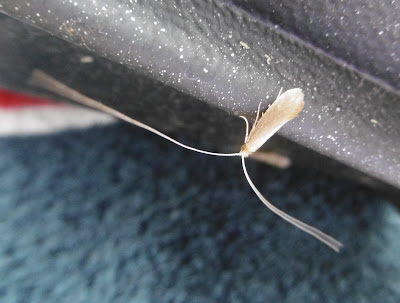 I thought my hawk moth tally for the year was complete, so this (above with my almost equally pink and beautiful thumb) came as a nice surprise this morning. A Small Elephant Hawk joined seven standard Elephant Hawks among the eggboxes on a very busy (and mild) night which saw a number of other interesting newcomers.
I thought my hawk moth tally for the year was complete, so this (above with my almost equally pink and beautiful thumb) came as a nice surprise this morning. A Small Elephant Hawk joined seven standard Elephant Hawks among the eggboxes on a very busy (and mild) night which saw a number of other interesting newcomers.As regular readers will be aware, I love Elephant Hawks because of their marvellous colouring. I think everyone does. I'm always very pleased when we have visitors on a day when an Elephant is slumbering in the trap. They never fail to win people over and do their bit to show that UK moths are not all small and brown.
In the last two pictures from my Pink Period above, you can also see a Heart and Club on an egg cone and then in the background on the red strip of my towel, a Burnished Brass. The latter are such lovely creatures - and also great examples of non-small, non-brown moths - that I'll unashamedly add a picture below of the two which came today, even though there's a BB in the trap every night at the moment.
The way the sheen is created by the refraction and reflection of light by hundreds of wingscales is as fascinating as the effect, and there is much learned material about it online.
Still on the newcomers list - this time of the year is the absolute zenith of moth activity - please kindly welcome, below, a Willow Beauty (I am pretty sure) and a Buff Arches, with that spindly calligraphy like the tugra or Sultan's cypher on documents from the Ottoman Empire.
I think we also have a possible Smoky Wainscot, below, although it's more than likely just a Common one. Help appreciated, as always.
Time for a little break now with some more familiar but always enjoyable guests: a big Silver-ground Carpet and another of the most excellent tribe of longhorn micro-moths. Like its predecessor the other day, it has chosen the underside of the bulb collar to roost.
And now, in this already inordinately long post, it's time to turn to yesterday's Three Grey Mystery Moths which have been the cause of much-appreciated advice both in Comments here and on the Upper Thames Moths blog. On advice from experts on the latter, I rephotographed the moths yesterday with a scale and in an attempt to get clearer pictures. I managed the scale as you can see but picture quality was another matter:
 Although there had been a suggestion on the UTM blog that one of the moths might be a Sycamore, and my anonymous commentor here ingeniously suggested a Tawny Shears, I think the revised photos show that all three are Large Nutmegs. One of the lessons I draw from this is that I must find a CD player to check out the detailed instructions for my Panasonic Lumix. It's getting better (or maybe I should say immodestly that I am), but it can still panic over dark moths on light backgrounds. In case you have been wondering about the sudden introduction of my towel to the blog's photos, that is the reason. I thought the camera might prefer moths seen against a slightly darker backdrop. I may be on to something here.
Although there had been a suggestion on the UTM blog that one of the moths might be a Sycamore, and my anonymous commentor here ingeniously suggested a Tawny Shears, I think the revised photos show that all three are Large Nutmegs. One of the lessons I draw from this is that I must find a CD player to check out the detailed instructions for my Panasonic Lumix. It's getting better (or maybe I should say immodestly that I am), but it can still panic over dark moths on light backgrounds. In case you have been wondering about the sudden introduction of my towel to the blog's photos, that is the reason. I thought the camera might prefer moths seen against a slightly darker backdrop. I may be on to something here.
There was also a bonus from this because during rephotographing, I came across a very small, blurrily pretty moth which I'd overlooked. On a whim, I stuck a picture of it, above, on the UTM blog with the hasty suggestion that it might be a Least Black Arches. The expert Martin Albertini put me right, saying that it was a Muslin Footman which he kindly described as "a much more interesting moth." We were both rewarded this morning by the arrival of two more - and actually, I should have recognised it as I see from my records that it came both last year and in 2013. I must have a colony. Here are today's two, below, which have the coincidental advantage of showing my camera problems: the Lumix has had trouble with the very dark background of the bulb collar but is much happier with the transparent trap rim resting on my famous towel.
Surely he can't go on even longer? Yes, but only to show you my latest butterfly photo - the tally here is well into double figures. This is a Large Skipper on Sweet William. Doesn't English nature have nice names?


















No comments:
Post a Comment